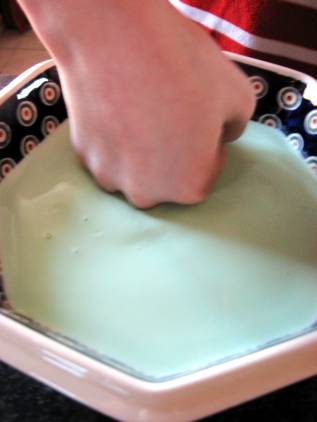 If you've ever seen the movie "The Blob," then you know the sight of a gelatin-like goo that oozes from place to place and still maintains it's shape. Now, imagine that, but when you move it around, it turns solid and when you let it go, it turns back into a liquid. Creepy, right? Well, all you need to do to make your own is mix water and cornstarch (pancakes not included). Our science class recently experimented with this method. It was a lot of fun to do and i encourage you to try it at home!
If you've ever seen the movie "The Blob," then you know the sight of a gelatin-like goo that oozes from place to place and still maintains it's shape. Now, imagine that, but when you move it around, it turns solid and when you let it go, it turns back into a liquid. Creepy, right? Well, all you need to do to make your own is mix water and cornstarch (pancakes not included). Our science class recently experimented with this method. It was a lot of fun to do and i encourage you to try it at home!We were assigned to make a conclusion for our project, which is what you are reading right now. Here is the synopsis of our research:
1.) The mixture was a thick, liquid-like substance that was smooth flowing, like molasses, yet hard at touch. Although it appeared to be a liquid, I believe that the "blob" was a solid. This is so because it was able to form a dense object when heat and pressure are added and it turned softer when they were taken away, although not soft enough to be a liquid.
2.) When handled, the mixture had a variety of reactions. If squeezed, the mixture becomes hard and controlled. If released, the mixture becomes loose and uncontrolable. The heat and pressure cause the molecules in the solution to be compact and stiff, which is the solid you get. After those traits are taken away, it turns back into glop. When I quickly put my finger in the gunk, it gets stuck because it gets hard when it feels the heat and pressure of your finger. When I slowly dip my finger in, it doesn't feel the change in pressure or heat, therefore my finger goes right through.
Conclusion:
This magnificent experiment is a facinating way of indirectly exploring the Earth's mantle. This is so because you are experiencing plasticity, which is the capability of being molded, receiving shape, or being made to assume a desired form (in this case, turning goo into a solid). Inside of the mantle, molten magma is being churned, which makes the lithospheric plates move (that's the cause of earthquakes). The plates move around on top of the magma, causing the magma to stay a liquid. If there was no plasticity, the Earth probably wouldn't exsist! Yeah, it's that important. So just think, the next time you do this experiment, think of how our Earth works (and think of my blog!!!)





No comments:
Post a Comment